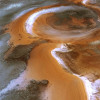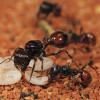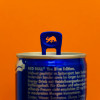Dead sea scrolls: DNA reveals biblical secrets
Interview with
The dead sea scrolls are a famous historical treasure - a trove of ancient manuscripts that include the earliest copies of parts of the Hebrew Bible. They’re so old that it’s been difficult for biblical scholars to actually piece them back together. But an unlikely collaboration between at Tel Aviv University has uncovered a clue that would make Sherlock Holmes proud: ancient DNA inside the manuscripts, from the animals whose skin they’re written on. Phil Sansom heard from the duo responsible, Oded Rechavi and Noam Mizrahi…
Noam - My name is Noam Mizrahi, and I've been studying biblical literature and the dead sea scrolls for some 20 years now.
Phil - What are these dead sea scrolls?
Noam - The dead sea scrolls is the remains of ancient manuscripts that were found along the shore of the dead sea. These texts come from the last centuries BC and the first century AD, and they represent the library of religious and literary texts of ancient Jewish society. Most of them have, unfortunately, disintegrated into thousands of fragments of various sizes, 25,000 fragments. And even though a lot of progress has been made, thousands of fragments are either not located at all, or we don't know where to place them exactly.
Phil - And then how did you get involved with your now colleague?
Noam - My coauthor, Oded, and I met on actually a retreat that the university had organised for new recruits and we found ourselves sitting next to each other in the bus.
Oded - Hi, I'm Oded Rechavi, and I'm a molecular biologist.
Phil - You were trying to get ancient DNA out of these bits of manuscript. How do you actually do that?
Oded - We can't really mess with these precious samples. We can't even touch the parchments, the people from the Israel, antiquities authorities do it for us, and we have to first make sure that we're not damaging the priceless samples. So the huge challenge here was to extract DNA out of tiny amounts.
Phil - How tiny amounts?
Oded - First of all, for many fragments that we would like to sample, we couldn't get a sample because they're too fragile to even sample. For other samples that were less fragile, the conservators just cut off very, very tiny amounts. And in other cases, they just let us have dust that fell off or scraped scroll dust off the fragments, and this is what we sequenced.
Phil - And I imagine the DNA in them, being a couple thousand years old, is in pretty rotten condition, right?
Oded - Right. First of all, to know that you are looking at ancient DNA, you have to look for ancient DNA patterns. Ancient DNA degrades in a predictable way. We look for these patterns in the DNA, indeed we found them, but it's important to understand that we only get a very partial coverage of the genome. Not like when you send the sample to a 23 and me here, you only get a fraction.
Phil - What did you find in there?
Oded - Unsurprisingly, perhaps without many contaminations, in addition to the authentic animal DNA. So microbes, but also human contaminations. This could be from the humans that handled the scrolls 2000 years ago or from the humans that handled them in modern times since their discovery in the last 70 years. We think that most of the contaminations come from the modern humans because they don't show these degradation patterns that characterise ancient DNA. But there are tons of human DNA in there that we had to get rid of computationally.
Phil - Is this like a needle in a haystack to find out what the parchments are actually made of?
Oded - It's not that bad, depending what your question is. Species identification was a problem that we could attack from multiple different angles because it wasn't clear which animals were used to make the scrolls. So we try to align the DNA that we sequenced to many animals and found that in the case of the scrolls, most of them are made from sheep. A small fraction are made from cow. We also identified the specific species of sheep and cow. In one case, we found that the few pieces that were thought to be part of the same scroll are actually made out of different animals.
Phil - Noam, were you surprised by any of the stuff that came out of the DNA?
Noam - I was very surprised by some of the results. For example, we looked into several fragments that were thought originally to belong to the same scroll, which was evidently a copy of the biblical book of Jeremiah. Nowadays, the book of Jeremiah looks the same, whether you open an edition of Jeremiah in London or in Tel Aviv or in Sydney. But in the Qumran scrolls, what we really find are widely divergent editions next to each other. We discovered that some of these fragments of Jeremiah are made from cow hides. Cows cannot be grown in the desert. It seems likely that these fragments come from scrolls that were prepared and written elsewhere. So we can now show for certain, for the first time, divergent texts of a prophetic book.










Comments
Add a comment